[TL;DR Summery] The fiddle leaf fig is a sculptural statement plant with violin-shaped leaves that thrives in bright, indirect light with proper watering. Choose between live plants (challenging to maintain) or low-maintenance faux versions, and position in corners or near windows for maximum visual impact.
Introduction: Why Your Home Needs a Fiddle Leaf Fig (But Probably Isn’t Ready)
A fiddle leaf fig isn’t just a plant—it’s an interior design statement that transforms bland corners into designer spaces. But here’s the problem: while this striking houseplant appears in nearly every aspirational home magazine, most people kill them within weeks.
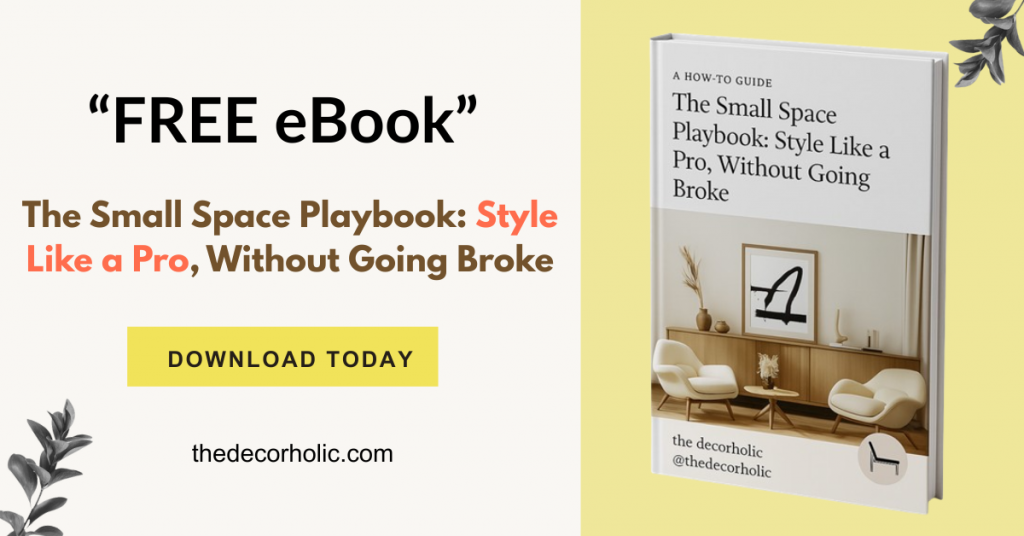
If you’ve scrolled through Instagram, you’ve seen fiddle leaf figs in minimalist living rooms, luxury boutiques, and million-dollar home tours. The visual impact is undeniable. Yet the reason behind this peculiar popularity is also why fiddle-leaf figs are so challenging: they’re difficult to care for.
Fiddle leaf figs are statistically the most problematic plant among houseplant owners, with yellowing and browning being the most common issues. This guide reveals exactly what separates successful fiddle leaf fig owners from frustrated plant killers—and introduces you to a game-changing alternative that lets you enjoy the aesthetic without the anxiety.
I. Why Fiddle Leaf Figs Have Dominated Interior Design for Over a Decade

Fiddle leaf figs became the go-to statement plant because they’re visually dramatic, photographable, and perfect for multiple design styles. The fig’s large, violin-shaped leaves create immediate sculptural impact in any room. As interior designer Brad Sherman notes, they have a “prehistoric, Dr. Seuss feel,” contributing a sense of whimsy and individuality to a space.
What makes this plant so magnetic is its versatility. Whether your aesthetic is minimalist, bohemian, global, or contemporary, a fiddle leaf fig works. The plant originally hails from West African rainforests and can reach 10 feet tall at maturity—making it perfect for filling awkward, barren corners that collect visual dead space.
The real reason they exploded in popularity? Social media. Before Pinterest and Instagram, fiddle leaf figs were just another houseplant. Today, they’re everywhere because with the rise of social media, these plants were made more visible to the mainstream, appearing in almost every major design blog or Instagram account—simply because they photograph exceptionally well.
The numbers tell the story. Over 35 million American households now own houseplants, and the global indoor plants market reached $20.68 billion in 2024—a surge driven by people desperate to bring life and design into their homes. Yet here’s the uncomfortable truth: over 50% of houseplant owners admit they don’t know how to properly care for their plants. Fiddle leaf figs, as the centerpiece of this trend, suffer the most. They’re everywhere because they’re beautiful. They fail everywhere because they’re unforgiving.
Pro Tip: If your goal is pure aesthetic impact and you’re not concerned with plant care, the faux fiddle leaf fig option delivers identical visual results without the maintenance stress.
Also: Expert Plant Styling Tips for a Stunning Home
II. The Real Challenge: Why Most Fiddle Leaf Figs Fail (And How to Fix It)

Most people struggle with fiddle leaf figs because they water incorrectly, provide insufficient light, or underestimate how finicky the plant actually is. This isn’t a beginner-friendly plant. It’s a statement piece that demands respect and attention.
Here’s what the research says: Overwatering accounts for roughly 45% of all plant deaths—and fiddle leaf figs are especially vulnerable to root rot. The average houseplant survives only about 2 years in a home before being replaced or discarded. For fiddle leaf figs, that timeline is often measured in months, not years. Fiddle leaf figs are statistically among the most problematic plants for home gardeners, with yellowing and browning leaves being the most common complaint.
The typical failure sequence looks like this: Owner buys a beautiful fiddle leaf fig. Owner waters it daily out of guilt. Leaves turn brown, drop off. Owner panic-waters more. Roots rot. Plant dies. Owner buys a faux one (finally happy).
Here’s what actually kills fiddle leaf figs:
- Overwatering remains the #1 killer. Too much moisture triggers root rot, which spreads quickly and is nearly impossible to reverse. Brown spots, yellowing leaves, and leaf drop all signal water problems.
- Insufficient light stunts growth and weakens the plant’s immune system, making it vulnerable to pests and disease.
- Temperature fluctuations and proximity to air conditioning vents shock the tropical plant.
- Dust accumulation on those large leaves reduces photosynthesis and invites spider mites.
- Poor drainage systems trap excess water even when watering frequency is correct.
Understanding these failure points transforms you from a plant killer to a plant parent. The good news? Fixing these issues requires just a few simple adjustments.
Pro Tip: Invest in a soil moisture meter ($8–15). These inexpensive tools remove guesswork from watering—take the stress out entirely and water only when the soil reaches the correct dryness level.
Also: Faux Plants Secrets to Decorate Like a Pro (And Fool Everyone!)
III. How to Style Your Fiddle Leaf Fig: Design Ideas That Actually Work
A fiddle leaf fig’s impact depends less on the plant itself and more on where you position it and what you pair it with. Strategic placement turns a nice plant into a design statement that transforms entire rooms. The key is understanding which styling approach matches your space and aesthetic.
The Classic Corner Play: The Foolproof Starting Move

Empty corners are decorating dead zones. A fiddle leaf fig solves this instantly. The plant’s architectural shape and height create visual interest in spaces that previously felt neglected. This positioning works in every room—living rooms, bedrooms, entryways, bathrooms, even home offices.
The unique shape and texture of a fiddle leaf fig’s large leaves stand out amongst other indoor plants, drawing the eye to otherwise bare spaces and making rooms feel more vibrant and intentional. Position your fiddle leaf fig in a corner that receives your brightest indirect light, and suddenly that forgotten corner becomes a focal point.
Pro Tip: Position your fiddle leaf fig near a window to ensure it gets the indirect sunlight it needs while maximizing visual impact from multiple viewing angles. This dual strategy solves both the care requirement and the design goal simultaneously.
Against White or Neutral Walls: Maximum Visual Pop
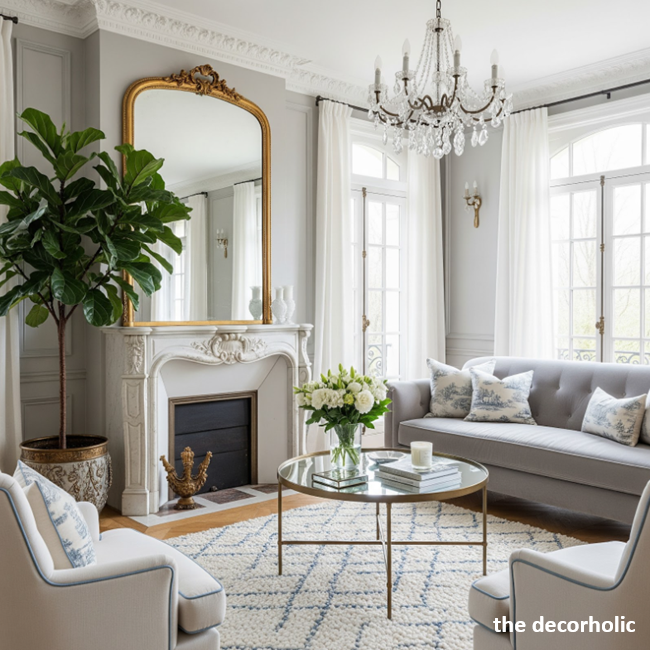
White and neutral walls make fiddle leaf figs sing. The contrast between the plant’s rich, glossy emerald leaves and minimal backgrounds creates dramatic visual interest without requiring any additional decor. Interior designers frequently specify this pairing in modern, minimalist, and Scandinavian-inspired spaces.
Fiddle leaf figs look particularly striking against white walls, which highlight the greenery and make the plant’s architectural form impossible to ignore. This pairing also works beautifully with soft gray, beige, and off-white backdrops. The plant becomes living art.
If you have bold, saturated wall colors (deep jewel tones, warm terracotta, or coral), a fiddle leaf fig still works—but it becomes part of a daring, eclectic aesthetic rather than a minimalist one. Fiddle leaf figs are striking against vivid wall colors, creating playful design gestures that show off both the plant and the room’s personality.
Pro Tip: If your walls are already busy with pattern or color, keep your fiddle leaf fig’s pot simple and neutral. Let the plant shine without competing visual elements.
Behind Seating Areas: The Backdrop Strategy

Position a fiddle leaf fig behind a sofa, armchair, or bed to create a natural visual bridge between your furniture and the room’s outer edges. This creates depth and sophistication while filling awkward spaces above or behind seated furniture.
In bedrooms, this placement adds height and greenery without taking up floor space. In living rooms, it transforms bare wall space into a curated vignette. The plant’s large leaves naturally frame seating areas and create an anchored, designed feeling.
Pro Tip: Ensure the plant doesn’t block artwork, mirrors, or architectural details. The goal is to complement these elements, not hide them.
Paired with Specific Pot Styles: Completing the Look
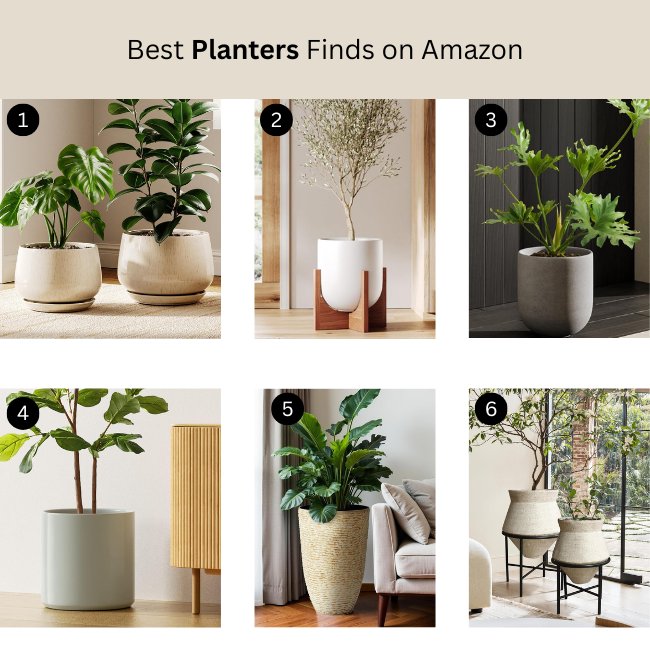
Ready to refresh your space? Shop my top planters picks below and instantly elevate your home’s style!
Planter 1 (set of 2) | Planter 2 | Planter 3 | Planter 4 | Planter 5
| Planter 6 (set of 2)
The pot matters as much as the plant. A modern white pot is trendy and versatile enough for any interior style, while natural baskets made from jute, rattan, or bamboo add a Bohemian vibe and soften the space with a bare, organic look.
- Minimalist spaces: White ceramic or light concrete pots emphasize clean lines
- Bohemian/eclectic: Woven baskets, macramé plant hangers, or textured linen wraps
- Mid-century modern: Tapered ceramic planters in warm neutral tones
- Maximalist: Jewel-toned or patterned pots that coordinate with your decor
- Industrial: Galvanized metal or concrete planters with edge
The pot you choose signals your design direction and completes the overall aesthetic. Textiles like linen or canvas covers can also frame your plant, adding warmth and intentionality to the design.
Pro Tip: Invest in a quality pot or basket cover that matches your space’s color palette. A fiddle leaf fig in a beautiful pot looks like a designed element. In a plastic nursery pot, it looks like something you forgot to upgrade.
Creative Placement Beyond the Obvious

Designer and plant expert Meg S. Miller points out that fiddle leaf figs work beautifully beyond predictable locations. A dining room fiddle leaf fig adds dimension and weight to otherwise airy spaces, balancing elegance with authenticity and preventing rooms from feeling overly statuesque or lifeless.
Other underutilized placements include:
- Bedrooms: Adds life and greenery without clashing with intimate spaces
- Entryways: Makes guests immediately feel welcomed by natural beauty
- Bathrooms: Thrives in humidity and transforms utilitarian spaces into spa-like retreats
- Nurseries: The bright contrast of large leaves against light walls captivates infants while adding beauty to the room
- Home offices: Creates a productive, calming workspace that feels connected to nature
- Patios and decks: Works beautifully outdoors in shaded areas and actually thrives with increased sunlight (especially for faux versions that don’t require precise care)
The Styling Rule That Changes Everything

The most important styling principle: A fiddle leaf fig should feel intentional, not accidental. Don’t just plop it in a random corner. Consider the sightlines from your main seating area. Position it where you’ll see it regularly. Pair it with a pot and styling that coordinates with your overall aesthetic.
Whether your design style is traditional, modern, eclectic, contemporary, transitional, or anything in between, the statement houseplant works in virtually every style imaginable because it adapts to its surroundings.
Pro Tip: Photograph your space before and after adding a fiddle leaf fig. Most people are amazed at how dramatically a single plant transforms a room. This visual proof justifies the investment immediately and confirms you made the right choice.
Trending Post: 10 Hottest Bedroom Trends to Try Now
IV. The Complete Fiddle Leaf Fig Care Blueprint: 5 Non-Negotiable Rules

To successfully maintain a fiddle leaf fig, follow these five specific care requirements: proper light, correct watering frequency, monthly fertilizing during growth, regular leaf dusting, and strategic repotting when roots emerge.
Light: The Non-Negotiable Foundation
Fiddle leaf figs demand bright, indirect light for 6–8 hours daily. Direct afternoon sun scorches leaves and causes browning. Position your plant near an east or west-facing window with sheer curtains, or about 2–3 feet away from an unobstructed south-facing window.
If natural light is limited, a grow light ($30–60) positioned 12 inches above the plant solves the problem without additional energy costs. Research indicates that LED grow light usage for indoor plants has increased by 25% in the last five years, reflecting how critical lighting has become for serious plant parents. Insufficient light leads to leggy, weak growth and leaf drop—so don’t compromise here.
According to horticulture experts, fiddle leaf fig trees flourish in warm temperatures, typically between 60–75°F during the day and no lower than 50–55°F at night. Consistency is key—rapid temperature changes can shock the plant and cause leaf drop.
Watering: The Most Critical Mistake to Avoid
Wait until the top inch of soil is completely dry before watering. This usually means watering every 10–14 days during growing season (spring and summer) and every 3–4 weeks in winter.
Use room-temperature, filtered water when possible. Tap water’s chlorine and minerals accumulate in soil and cause brown leaf tips. Water at the base of the plant to prevent fungal issues. Ensure your pot has drainage holes—non-negotiable.
Fertilizing: Monthly Feeding During Growth Season
Apply a balanced liquid fertilizer (10-10-10 NPK ratio) once monthly from March through September. Reduce to once every two months in fall and stop entirely in winter. Over-fertilizing burns roots and concentrates salts in soil, so follow the label’s recommended dilution exactly.
Dusting: The Overlooked Maintenance Step
Dust leaves monthly with a soft microfiber cloth or soft-bristle brush. Dust blocks photosynthesis and attracts spider mites. For severe dust buildup, give the plant a gentle lukewarm shower in your bathtub or outside.
Repotting: Know When to Upgrade
Repot only when roots begin poking above the soil surface or coming out drainage holes. This typically happens every 12–18 months. Use well-draining potting mix (add orchid bark for extra drainage). Spring is ideal for repotting.
Pro Tip: Create a simple phone reminder calendar with these five tasks. Set a monthly “Fiddle Leaf Fig Care Day” and batch all five activities at once. This eliminates the guesswork and keeps your plant thriving.
Don’t Miss: Pastel Wall Colors – Your Guide to Serene, Stylish Spaces
V. Live vs. Faux: Which Fiddle Leaf Fig Solution Actually Wins?
Live fiddle leaf figs offer authentic plant energy and air-filtering benefits, while faux fiddle leaf figs provide identical visual impact with zero maintenance—making the faux option ideal for busy professionals, apartments with limited light, or design-focused homeowners who aren’t interested in plant care.
The decision comes down to your lifestyle and priorities.
Live Fiddle Leaf Figs: When They Make Sense

Choose a live plant if you:
- Enjoy plant parenting and are willing to commit to the care regimen above
- Have adequate bright, indirect light in your home (this is non-negotiable)
- Appreciate the air-filtering qualities of live plants (NASA research confirms houseplants like fiddle leaf figs have genuine air-purifying properties)
- Want the authenticity of a real plant
The cost: $40–$150 depending on size and source.
The hidden cost: Your time, attention, and psychological stress when it starts dropping leaves. Many people underestimate the emotional toll of watching a plant slowly die despite your best efforts.
Faux Fiddle Leaf Figs: The Honest Case

Choose a faux plant if you:
- Live in an apartment with poor natural light
- Travel frequently and can’t maintain consistent watering schedules
- Prefer design impact without maintenance
- Want guaranteed success (no brown leaves, no guilt)
- Value your time more than authenticity
The cost: $60–$200 depending on size and quality. Premium faux plants look indistinguishable from real plants from 3+ feet away.
The honest truth: High-quality faux fiddle leaf figs now look remarkably realistic. Designers increasingly specify faux versions in commercial and residential projects precisely because they perform reliably while maintaining visual impact. There’s no shame in choosing the practical option.
Pro Tip: If you purchase a live fiddle leaf fig and it starts struggling, don’t feel guilty switching to faux. A thriving, beautiful faux plant beats a dying, guilt-inducing real plant every time. The design goal is achieved either way.
Trending Post: A Guide to Creating a Girly Apartment Decor
VI. The Non-Negotiable Positioning Strategy: Where to Place Your Fiddle Leaf Fig

Position your fiddle leaf fig in a high-traffic corner, near windows for visual brightness, or as a focal point in open floor plans—anywhere it commands attention while receiving appropriate light.
The magic of a fiddle leaf fig lies in where you place it, not just that you own it.
Corner placement (the classic move): Position your fiddle leaf fig in a tall, overlooked corner to instantly anchor and elevate that space. This works whether your plant is live or faux. The corner stops feeling like dead space and becomes a designed focal point.
Near windows: Position the plant 2–3 feet from a south or west-facing window for optimal light. This works for live plants and simultaneously creates a beautiful silhouette effect for faux plants.
In open floor plans: Place your fiddle leaf fig between living and dining areas or kitchen spaces to define zones and create visual interest. The plant acts as a natural room divider.
Avoid these placements:
- Direct sunlight exposure (burns live plant leaves)
- Spaces near heating vents or air conditioning (temperature shock)
- Low-light corners (dead plant or ineffective faux plant)
- High-traffic areas where people will brush against leaves
Pro Tip: Photograph your space before adding a fiddle leaf fig, then after. The visual difference justifies the investment immediately—whether you choose live or faux.
Don’t Miss: Best Jewel Tone Paint Colors for a High-End Home Makeover
VII. Where to Buy: Best Live and Faux Fiddle Leaf Fig Options
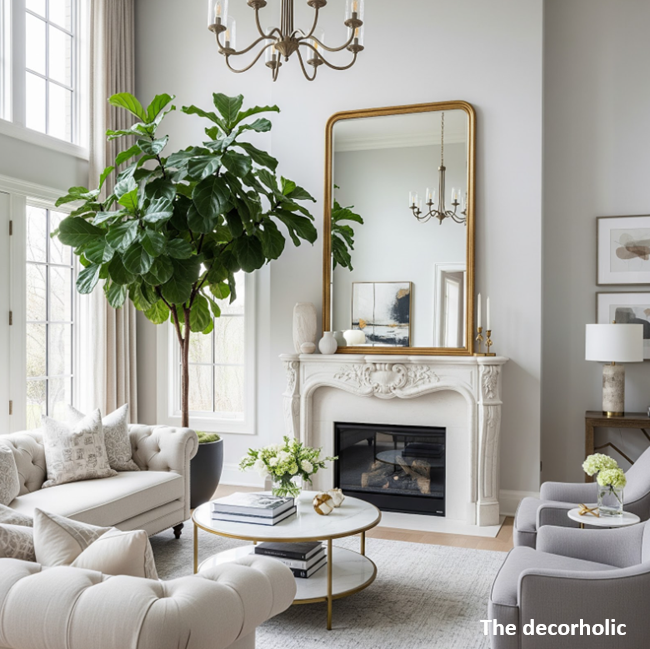
Live Fiddle Leaf Figs: Buying Smart
Local nurseries offer the advantage of inspecting the plant’s health before purchasing and accessing expert guidance immediately. The downside: limited selection and often higher prices than online options.
Online retailers like Bloomscape, The Sill, and Costa Farms ship healthy, medium-sized plants directly to your door. These sites often provide care guides and customer support.
Amazon offers fast shipping and competitive prices, but quality varies significantly between sellers. Read reviews carefully and look for sellers who ship in protective boxes.
Garden centers like Lowe’s and Home Depot stock budget-friendly options, though plant health can be inconsistent due to store-level care gaps.
When buying, inspect the plant for:
- Green, firm stems (no mushy or darkened areas)
- Firm leaves without brown spots or yellowing
- Moist (not soggy) soil
- Strong overall appearance
Faux Fiddle Leaf Figs: Premium Options That Look Real
The faux plant market has exploded, and high-end options now look remarkably authentic:
- Premium silk fiddle leaf figs ($80–$200) from specialty home decor retailers use real-touch silk leaves that photograph beautifully. These are investment pieces that last 5+ years.
- Amazon’s top-rated faux options ($60–$120) offer excellent value and typically arrive in compact boxes that fluff out into full-sized plants.
- West Elm, Article, and CB2 carry designer faux plants that match specific aesthetic directions (minimalist white pots, natural wood planters, etc.).
Quality markers for faux plants:
- Individual, naturally-varied leaf shapes (not uniform/plastic-looking)
- Properly weighted base for stability
- Pre-fluffed or easily shaped branches
- Realistic pot included or pot compatibility
Don’t Miss: 9 Small Powder Room Genius Hacks

VIII. Your Fiddle Leaf Fig Solution (Live & Faux Best Finds Options On Amazon)
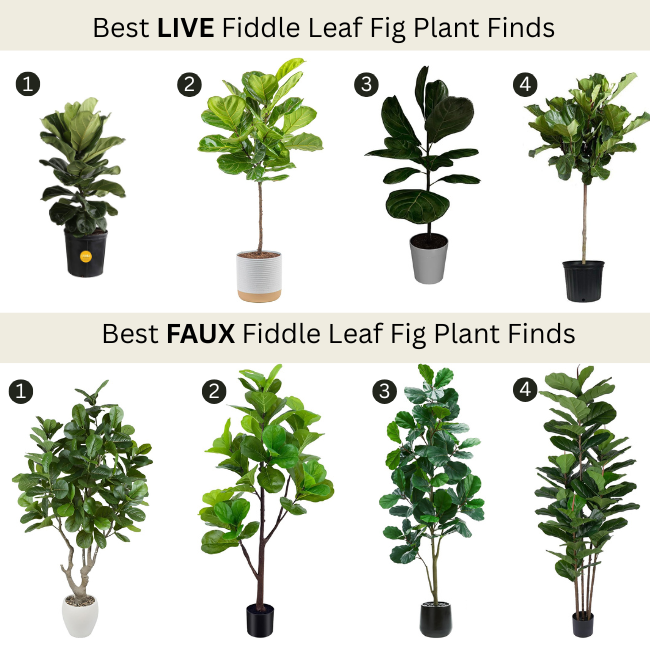
Stop wasting time researching. You’ve read the care guide, you understand your lifestyle, and you know whether live or faux is right for you. The options below solve your specific problem—whether that’s transforming an empty corner, investing in a long-term statement piece, or finally getting the designer aesthetic without the plant-parent guilt. Each option ships quickly and arrives ready to position in your space.
Plant 1: Best Premium Live Option – Fast Shipping & Thriving Plants

Modern Beige Sectional Sofa (The Best One!)
Spacious, soft, and perfect for cozy evenings. The neutral tone blends seamlessly with any decor.
Check Price on Amazon →This option delivers healthy, established live fiddle leaf figs in protective packaging. Perfect if you’re genuinely committed to the care regimen and want a plant that’s already matured past the fragile seedling stage. You’ll receive a plant ready to flourish in your bright, indirect light setup—no waiting months for growth. This solves the problem of receiving weak or struggling nursery plants. Order today and your fiddle leaf fig arrives within days, not weeks.
Pro Tip: Upon arrival, let the plant acclimate to your space for 3–5 days before moving it to its final position. This prevents shock-induced leaf drop.
Plant 2: Best Value Live Option – Perfect for Budget-Conscious Buyers

Modern Beige Sectional Sofa (The Best One!)
Spacious, soft, and perfect for cozy evenings. The neutral tone blends seamlessly with any decor.
Check Price on Amazon →Get the same visual impact at a fraction of the premium price. This option removes the guilt of investing heavily when you’re still testing your plant-parent commitment. Many buyers purchase this option, succeed with the care routine, then upgrade to a premium specimen later. This is the smart starter move. Start here, prove your commitment, upgrade later if you want.
Pro Tip: Pair this with a soil moisture meter (under $15). Remove the guesswork entirely and water only when the meter confirms dryness. This one tool prevents 90% of fiddle leaf fig failures.
“Ready to refresh your space? Shop my top decor picks below and instantly elevate your home’s style!”
Plant 3: Best Established Size – Skip the Waiting Game

Modern Beige Sectional Sofa (The Best One!)
Spacious, soft, and perfect for cozy evenings. The neutral tone blends seamlessly with any decor.
Check Price on Amazon →You don’t have time to wait 2–3 years for a fiddle leaf fig to grow tall enough to fill your space. This option delivers a mature, substantial plant that commands immediate visual impact. Skip the slow-grow frustration and position a designer-quality specimen in your home this week. Your corner transforms instantly—not years from now. This is for buyers who want results now, not promises.
Pro Tip: Position this near your best natural light source immediately. Mature plants have established root systems and handle positioning changes better than smaller specimens.
Plant 4: Premium Delivery Experience – The Insurance Option

Modern Beige Sectional Sofa (The Best One!)
Spacious, soft, and perfect for cozy evenings. The neutral tone blends seamlessly with any decor.
Check Price on Amazon →This premium option includes a care guarantee and responsive customer support. If something goes wrong, you have backup. This solves the anxiety of investing $100+ and having zero recourse if the plant arrives damaged or dies within the first month. Peace of mind included. Order this if you want expert support behind your purchase.
Pro Tip: Screenshot the care instructions included with this option. Pin them to your phone’s lock screen as a weekly reminder. Consistent care beats sporadic heroic efforts.
Faux Fiddle Leaf Fig Options: The Guilt-Free Choice
Plant 1: Best Premium Faux – Indistinguishable From Real

Modern Beige Sectional Sofa (The Best One!)
Spacious, soft, and perfect for cozy evenings. The neutral tone blends seamlessly with any decor.
Check Price on Amazon →This is the option designers specify in luxury homes and high-end commercial projects. Real-touch leaves, realistic weighted base, and branches that move naturally. From 3+ feet away, no one will know it’s faux. More importantly, you’ll enjoy your beautiful statement plant without the stress, guilt, or failed watering schedules. Your corner looks designed. Your life stays simple. This is the “best of both worlds” option—designer aesthetic, zero maintenance.
Pro Tip: Dust this monthly with a soft microfiber cloth to maintain the realistic appearance. Five minutes of maintenance per month beats the weekly commitment of a live plant.
Plant 2: Best Budget Faux – The Smart Starter

Modern Beige Sectional Sofa (The Best One!)
Spacious, soft, and perfect for cozy evenings. The neutral tone blends seamlessly with any decor.
Check Price on Amazon →Excellent reviews, arrives compact and fluffs into full size, and costs a fraction of premium faux options. Perfect if you want to test whether a fiddle leaf fig actually fits your aesthetic and space before investing heavily. No shame in trying the budget version first. Many buyers upgrade to premium faux later. This removes the risk—test drive the look without the financial commitment.
Pro Tip: Position this in your space for a week before committing to the final placement. Live with the visual impact first, adjust positioning second, finalize third.
Plant 3: Best for Specific Decor Styles – Matches Your Aesthetic

Modern Beige Sectional Sofa (The Best One!)
Spacious, soft, and perfect for cozy evenings. The neutral tone blends seamlessly with any decor.
Check Price on Amazon →Curated to match specific design directions (minimalist, boho, mid-century modern, etc.). Your fiddle leaf fig doesn’t just fill space—it cohesively fits your entire design language. This solves the problem of buying a beautiful plant in a pot that clashes with your style. Everything matches. Everything looks intentional. This is for buyers who understand that the pot is part of the design.
Pro Tip: Screenshot the image of this option and save it to your phone. Show it to friends/family, get validation, then order confidently. Social proof works.
Plant 4: Best Premium Faux – The Investment Piece

Modern Beige Sectional Sofa (The Best One!)
Spacious, soft, and perfect for cozy evenings. The neutral tone blends seamlessly with any decor.
Check Price on Amazon →This premium faux option lasts 5+ years without fading, degradation, or looking plastic. It’s the option you buy once and never replace. Real-touch technology, designer-quality presentation, and absolutely no maintenance. Position it, enjoy it, never think about it again. This is for buyers who want to solve their “bare corner” problem permanently.
Pro Tip: Invest in a quality plant stand or floor planter that complements your space. The fiddle leaf fig is the star, but the stand is supporting cast—choose accordingly.
Most Popular Post:
Interior Design Style Quiz
Timeless Paint Colors That Never Go Out of Style
Create Your Perfect Ergonomic Home Office: A Complete Guide
Must-Have Accessories for Guys: The Secret to a Stylish Space
Modular Sofas for Small Spaces: Brilliant Solutions for Compact Living
Final Decision: Make Your Choice and Transform Your Space
You now understand the complete reality of fiddle leaf fig ownership. You know the care requirements, the failure points, the aesthetic benefits, and the honest cost-benefit analysis of live versus faux.
Here’s the truth: A thriving faux fiddle leaf fig beats a slowly-dying real one every single time.
Too many people buy expensive live plants, watch them decline despite good intentions, experience guilt, then eventually trash them. That’s not design success—that’s waste.
The real win is choosing the option that aligns with your life. Choose live if you’re genuinely ready for the commitment. Choose faux if you value your time and want guaranteed visual impact.
Either way, your blank corner becomes an intentional, designed space. Your room transforms. Your space tells a story. That’s what matters.
Take action today: Choose your fiddle leaf fig option above, commit to the placement strategy, and position it in your space this week. Don’t overthink this. A designed home beats a bare one, and you now have all the information to succeed either way.
This post may contain affiliate links. I earn a commission on qualifying purchases at no additional cost to you.
Fiddle Leaf Fit Plant–Frequently Asked Questions
Q: How long do fiddle leaf figs live if I care for them properly?
A: Live fiddle leaf figs can live 20+ years with consistent proper care. However, most people underestimate the care commitment required and give up within the first 1–2 years.
Q: Can I keep a fiddle leaf fig in low-light spaces?
A: No. Live fiddle leaf figs require bright, indirect light for 6–8 hours daily. In low-light spaces, your plant will weaken and eventually die. Use a faux plant or add a grow light instead.
Q: Why are the leaves on my fiddle leaf fig turning brown?
A: Brown spots indicate either overwatering (most common), inconsistent watering, or mineral buildup from tap water. Switch to filtered water and allow the top inch of soil to dry completely between waterings.
Q: Is a faux fiddle leaf fig considered “cheating”?
A: No. Interior designers specify faux plants in high-end commercial projects because they provide reliable visual impact. A faux plant that looks beautiful is infinitely better than a struggling real plant.
Q: How do I increase humidity for my fiddle leaf fig?
A: Place the plant on a pebble tray filled with water (roots don’t touch water), mist the leaves weekly, or position it near a humidifier. High humidity helps prevent spider mites and supports leaf health.
Q: Can I propagate my fiddle leaf fig?
A: Yes, but it’s challenging. Fiddle leaf figs propagate through air layering or leaf cuttings, though success rates are low. Most people find it easier to purchase new plants than to propagate.
Subscribe To the Newsletter!
Subscribe now for an endless feed of inspirational women’s cave decor ideas, pampering rituals, and more tips for curating your ultimate escape. Let’s start making your cozy refuge a reality – you so deserve this!
CATCH THE LATEST IN HOME DECOR TRENDS:
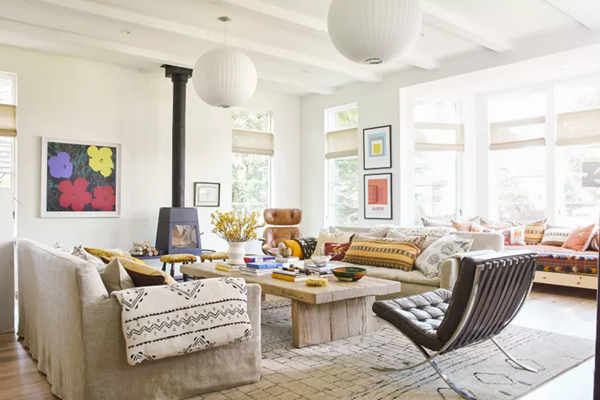
Steal These 16 Expert-Approved Decorating Secrets

How To Accessorize Your Living Room
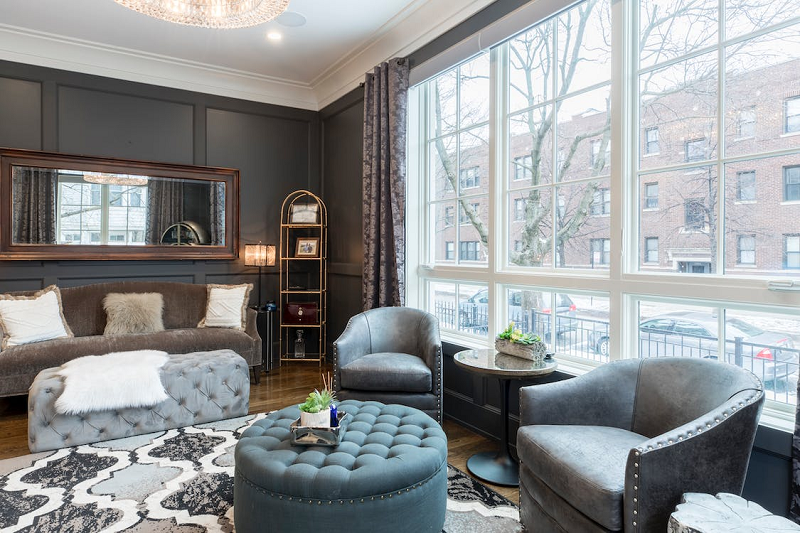
Small Space? 10 Ways To Make A Room Appear Bigger
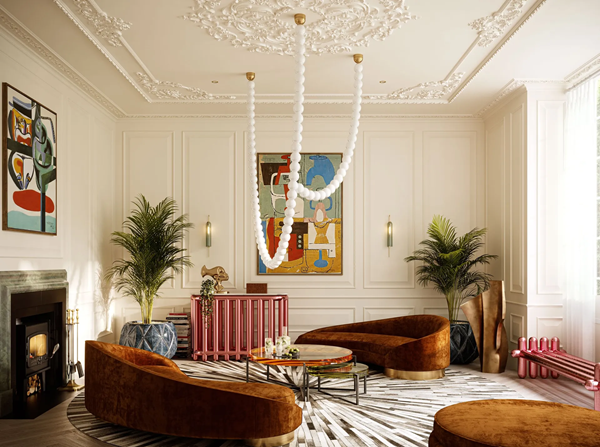
Make Your space Look Expensive
GET CAUGHT UP ON ALL THE INSPIRING DECOR TIPS:
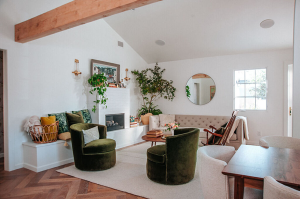
18 Fresh Decorating Ideas To Update Your Fireplace

How To Create An Art Gallery Wall


